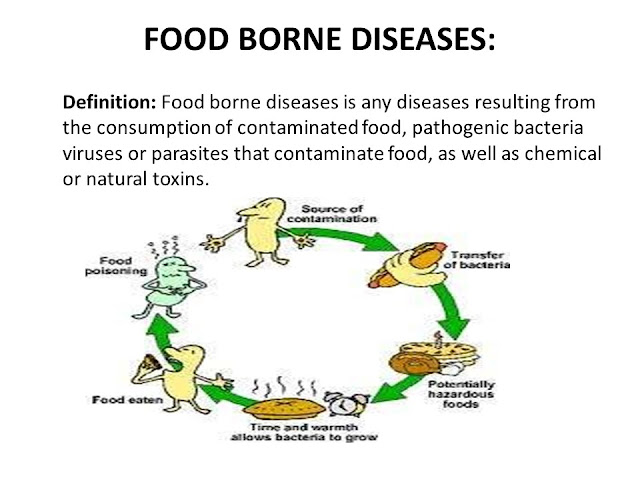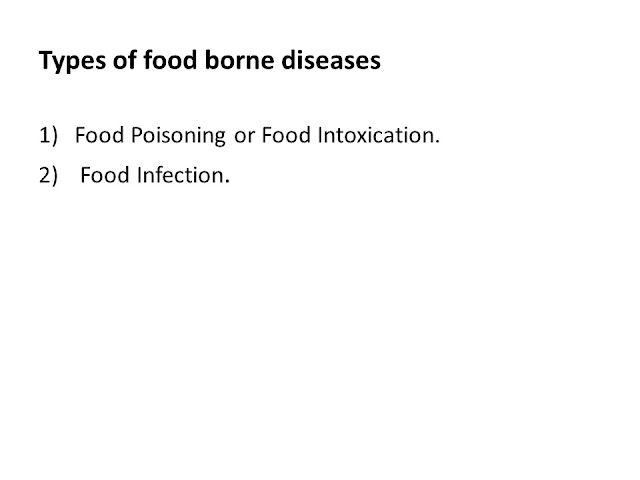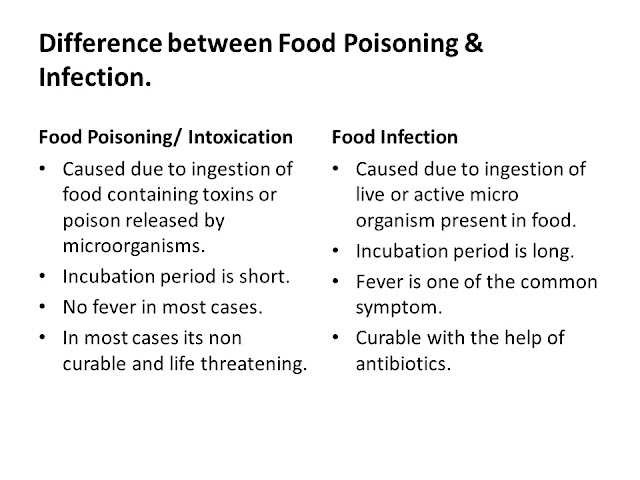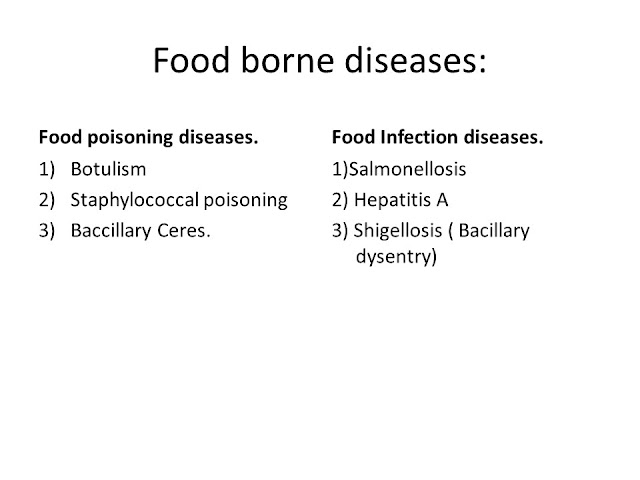FOOD BORNE DISEASES
Food borne illnesses are conditions of distress following
the ingestion of food or drink. Such illnesses may strike one person or
hundreds of persons in a single outbreak, and may be only mildly and
temporarily unpleasant, or fatal. They are microbial and non – microbial in
origin.
There are 11 major types of food borne illnesses: -
1. Indigestion
2. Food intolerance or food sensitivity
3. Algae toxins
4. Metal poisons
5. Phyllotoxins
6. Manufactured agricultural & household chemicals
7. Zootoxins
8. Protozoan disease
9. Infestation
10. Microbial infections
11. Bacterial & fungal food intoxications.
1. INDIGESTION: - is acute food borne distress which follows
wilful neglect or violation of good eating habits. Symptoms of distress, acute
abdominal pains, and vomiting.
2. FOOD INTOLERANCE OR SENSITIVITY: - food sensitivities are
the food related reactions termed allergy, immunological hypersensitivity – i.e.,
manifestation of the antigen – antibody reactions following ingestion or
contact with food hypersensitivity to milk, wheat flour & eggs is common.
3. ALGAE TOXINS: - Three divisions of algae namely: -
• Pyrrophyta (dinoflagellates) e.g., Gonyaulax Catenella, G.
monilata.
• Cyanophyta (blue – green algae) e.g., anabaena flos –
aquae, microcystis aeruginosa.
• Chrysophyta (golden brown algae) e.g., prymnesium parvum.
All the organisms occur both in fresh & marine waters, but almost
invariably incidents of shellfish poisoning occur in seawater.
4. METAL POISONS: - Both mineral and organic material toxic
to man & animals are widespread in environment. They occur in foods, often
as normal constituents. The prominent intoxicating mineral elements are
arsenic, lead, mercury, and selenium
5. PHYLLOTOXINS: - many plants produce substances with pharmacological
and toxic effects on humans and animals e.g.
• ANTIENZYMES: - plant - soya beans, legumes, potato. Action
– trypsin.
• CARCINOGENS: - plant – senecio. Action – liver damage.
• GOITROGENS: - plant – cabbage and some fruits. Action –
enlargement of thyroid.
6. Manufactured agricultural & household chemicals: -
insecticides, pesticides, growth regulators, fungicides, and growth simulators
e.g. cryolite, lead arsenate, DDT(dichloride – diphenyl – tri – chloroethane).
Most chemicals are looked upon as adulterants of food. Regulatory control
dictates the care that must be exercised in their handling & use, time of
application & residues permitted.
7. ZOOTOXINS: - Zootoxins are associated only with
freshwater & marine foods. It is microbial deterioration of the fish after
capture.
8. PROTAZOAN DISEASE: - e.g., Amebiasis – or amoebic
dysentery. Its prevalence is influenced by cultural practicelike by disposal of
human waste in such a way that food & water are contaminated. Effective
sanitation is necessary to control amebiasis.
9. INFESTATIONS: - Helminthic infestations are illness
caused by cestodes (parasitic, highly segmented flat – worms), trematodes (parasitic,
unsegmented flatworms) and nematodes (long, cylindrical, unsegmented worms).
Many infestations are associated with foods characteristic of specific
geographic areas. all food borne infestations entre the human through food
& water, it is also transferred during the handling of the meat. E.g.,
Ascariasis, enterobiases, taeniasis.
10. MICROBIAL INFECTIONS: -
INTESTINAL ILLNESSES
I. streptococci: - it is caused by streptococcus phylogenies.
It is responsible for acute, pus forming infections. Common vehicles for
spreading the disease are raw milk & cream contaminated by infected
farmers.
II. Salmonella: - caused by Salmonella. Salmonella, or
enteric fever lies affected humans for centuries. The symptoms are fever, septicemia,
and gastroenteritis. The agent of thyroid is Salmonella typhi. Symptoms – high
fever incidence occur through contamination of well water, milk & foods.
III. Shigellosis: - shigellosis of bacillary dysentery is
caused by organism belonging to genus shigella. Commonly associated with milk
& ice cream.
IV. Cholera: - it is transmitted by contaminated water,
fruits, vegetables, raw/ half cooked fish. Caused by vibrio cholera
NON-INTESTINAL ILLNESSES
(i) Tuberculosis: caused by Mycobacterium tuberculosis.
Sputum, nasal exudates, unpasteurized milk, uninspected meat & poultry.
Food related TB is less often respiratory than gastrointestinal, skeletal, and
glandular. & Muscular.
(ii) Listeriosis: - caused by listeria, monocytogenes.
(iii) Q fever: - caused by Coxiella Burnette. Out breaks
seen in meat packaging plants. Causes fever, severe pneumonia.
11. BACTERIAL & FUNGAL FOODBORNE INTOXICATION: -
Although many different organisms can grow in foods, only few produce toxins
that make the food dangerous to eat among bacteria e.g., are staphylococcus
aureus, clostridium perfringens, c. botulinum & bacillus cereus. Among
fungi e.g., Claviceps purpurea fusarium, aspergillus penicillium.
(i) S. Aureus – it resides in the mucous of nose &
throat region. The bacteria leave the nose & month in nasal secretions.
During coughing & sneezing. It causes osmoles, boils, abscesses,
meningitis, and pneumonia. S.A. produces enterotoxins (toxins). It causes
irritation of intestinal tract, cramps, coma, and death.
(ii) Botulism: - It is neuroparalytic disease causes by
consuming foods contaminating toxin of clostridium botulinum. Faulty vegetable processing,
fish & FP, fruits, milk & MP.
(iii) Ergotism: - Caused by Claviceps purpurea, a fungal
pathogen of rye, barley, wheat and produces a toxic product called ergot.
Fungal tissue grows on the grains having alkaloids which have toxic
characteristics.
(iv) Aflatoxins: - Caused by mold aspergillus flowers. A
wide variety of commodities. Like almonds, bakery products, millet, peanuts,
wheat flour etc. symptoms are jaundice, hepatitis, hypertension, carcinogenic
in nature.















Thanx for sharing informative post. Please keep sharing!
ReplyDeletehttps://www.delicozy.in/